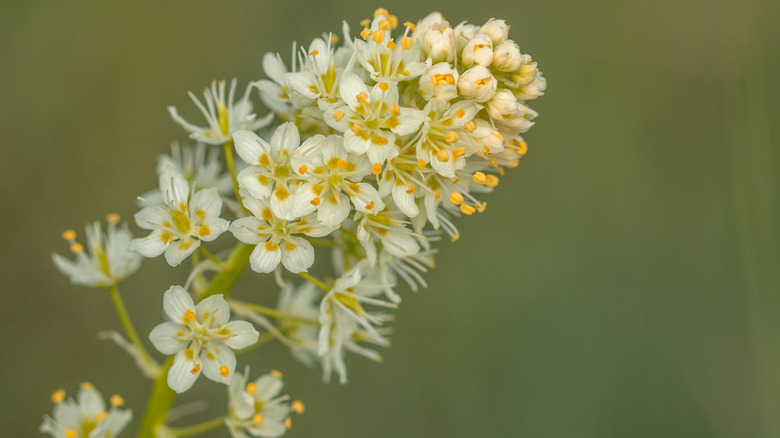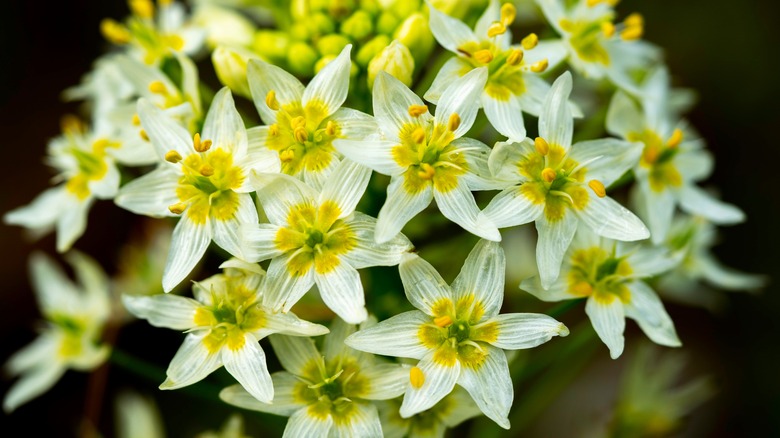The Gorgeous But Toxic Flowering Plant You Don't Want To Find In Your Yard
We may receive a commission on purchases made from links.
While some wildflowers can be a beautiful feature in backyard gardens, certain varieties have the potential to harm animals and people. Death camas (Zigadenus paniculatus) is a gorgeous yet poisonous plant that's found throughout a predominant portion of the United States, including both the west coast and the northeast. A subset of the nontoxic common camas, this plant can flourish in a variety of climatic zones, including mountainous and sandy regions.
Death camas is particularly dangerous because it can be easily mistaken for harmless look-alikes, including wild onions. Symptoms of death camas poisoning include excessive salivation, nausea, vomiting, and blood pressure dysregulation, which can lead to cardiac arrest. The U.S. Department of Agriculture notes that the plant also poses significant risk to ranchers and their livestock, as exposure can have devastating effects on the health of cattle, sheep, pigs, horses, and goats. It is imperative to learn tactics for both identifying and removing this toxic perennial you don't want in your yard to ensure the safety of both humans and animal companions.
How to identify death camas
Death camas may be pretty to look at, but don't be fooled by the plant's lovely appearance. Since they are a subset of the lily plant, mature flowers may be mistaken for common lilies that are often incorporated into gardens or bouquets. Picking wildflowers can be a fun and relaxing family-friendly activity, but it's important to be thoroughly educated before touching or consuming any flowers you may find in nature.
To identify these perennials, look for plants that range from 6 to 28 inches tall, with onion-shaped root bulbs that are nestled approximately 2 to 8 inches below the ground. The flowers are usually white or cream colored and have six small petals. They blossom in clusters of three from the tip of the plant down to the stem. When looking inside the petals, you may see yellow or green nectar glands. Death camas plants reach maturity during the summer months.
Some people who have experienced poisoning say they mistook the plant for edible wild onion bulbs, which have a similar aroma and appearance. These two plants may look alike to an untrained eye, but there are distinct differences between them. One of the best ways to tell the difference is that wild onion leaves will feel similar in texture to succulents with a U-shaped divot in the center, while death camas leaves typically are more grass-like in structure.
Removing death camas from your garden
It is recommended to remove death camas from your property as soon as possible to mitigate potential harm. To avoid cross-contamination and accidental ingestion, remember to wear gloves when handling the plants and thoroughly wash your hands after removal is complete. Underground bulbs that are left in the soil have the ability to regrow new stems and flowers. Therefore, to completely eradicate patches, the entire plant must be removed from root to tip.
Start by digging up the plant and bulb when the soil is damp, making sure that all the roots are completely removed. Mowing is ineffective, as regrowth will occur quickly once the area is left undisturbed again. On the other hand, herbicides can be useful for removal, especially when you're dealing with a large swath of land. As discovered in a 2020 study published by Weed Technology, there have been positive results using 2,4-D, 2,4-D + triclopyr, and imazapic. Roundup Extended Control, which contains imazapic, can be purchased through Amazon for about $12 for 24 fluid ounces.
Prevention is also key, especially for farmers and ranchers. Grazing animals that are underfed are at an increased risk of ingesting deathcamas, as hunger can make animals seek nourishment from plants outside of their typical diet. To ensure your animals are meeting all of their nutritional needs, consult with a veterinarian about the appropriate amount of food for each animal according to breed, weight, age, and activity level.


